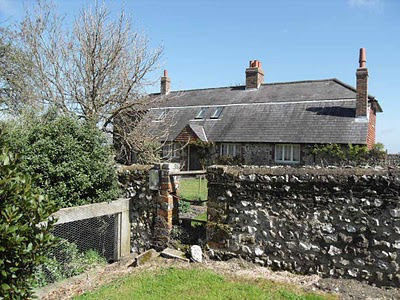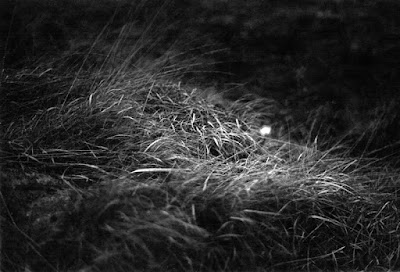Thinking of Ravilious, I'm reminded of a trip I made to Barra to visit a close friend who was staying in the croft house that was owned by Ravilious' old friend, the designer and artist Peggy Angus. Ravilious didn't visit Barra as far as I'm aware, but made much work at Peggy's other house "
Furlongs" on the South Downs.
 |
| Eric Ravilious - Furlongs |
 |
| exterior of Furlongs |
I think familiar, well loved places are of great importance to a great many artists, particularly those concerned with landscape, and it seems that Furlongs was one such place for Ravilious.
I'd never been to Barra before. We arrived at Peggy's house at twilight off the surprisingly long ferry journey from Oban, cycling along the single track road just being able to make out the house in the fading light, to find my friend in a magically evocative place lit by candles and the light from a log fire, cooking on a portable gas stove, and surrounded by years of accumulated objects of interest gathered by Peggy. It's a primitive space (Jim and I slept on an extremely smoky platform above the "kitchen" area), and not one for those looking for luxury (indeed, it's not much more luxurious than many a bothy) but it's spartan qualities are made up for with an abundance of character. The house is just as she left it before she died, and is still used by the family for holidays (my friend is close to the family). Unfortunately I didn't take any decent pictures of the house, but I do understand how places become closely linked with the creation of artworks, and have had similar experiences with places I've become intimately acquainted with over the years in Scotland.
There's a house in the West coast that, due to the generosity of an aunt and uncle, I was able to regularly visit throughout the 1990's and early 2000's, and where I made much of my first photographic work. In part, it's joys stemmed from a simple escape from the city. The place itself, with no road access - the easiest way to reach it was by rowing across the loch - a place where time and the pace of life seemed to slow down, where there was no TV, telephone, (and latterly, mobile reception) encouraged a reflectiveness that nourished my creativity. I visited usually around three times per year, most often bringing friends, but also sometimes visited alone. This was probably the only place where I've gone a whole week without uttering a word to another human and experienced real solitude, bar hearing a voice on the radio.
 |
| L Punton, where deer sleep, silver gelatin print, 1996 |
Back in Barra, we climbed the island's highest hill, the relatively small
Heaval, enjoying the view around the island down to Castlebay, a view presumably familiar to Peggy Angus and to those that would have
regularly come to visit.
 |
| view from the summit of Heaval, Barra |








